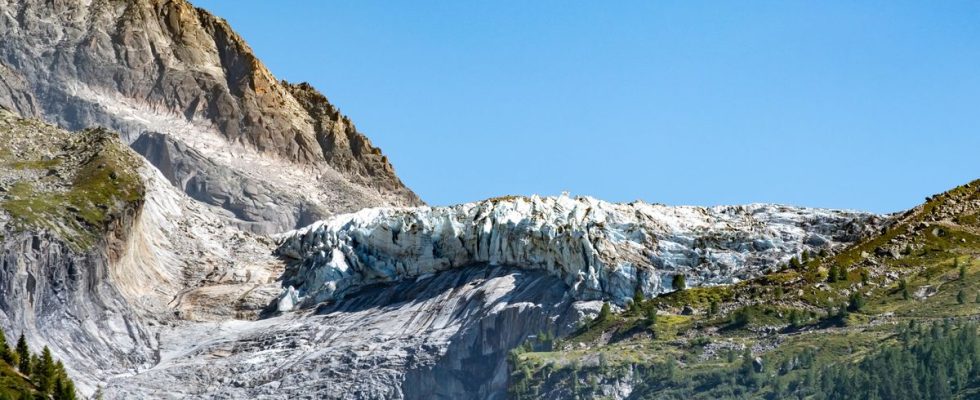The Tré-la-Tête glacier, in the Mont-Blanc massif, is no exception. Like so many others around the world, it has continued to melt in recent years. The fourth largest glacier in France is still imposing… “But in eight years, it has lost around 15% of its mass and we have broken all the melting records since 1850 in recent years,” says Jean-Baptiste Bosson, glaciologist at the Haute-Savoie Conservatory of Natural Spaces (CEN).
These disappearing immensities of ice then expose the last areas of virgin nature on Earth. “At the beginning, the universe is very mineral. It’s essentially rock, pebbles, continues the glaciologist. But vegetation eventually arrives, soils develop, forests arise, rivers swell, lakes are formed…”
At Tré-la-Tête, the birth of a lake
Processes are slow at high altitudes, but can be much faster lower down. At the foot of Tré-la-Tête, forests of larches and D’spruces have already hatched in place of the ice. “And at an altitude of 2,000 meters, we are currently witnessing the birth in real time of a lake,” says Jean-Baptiste Bosson. In this new setting, wildlife ends up showing up. You can see ibexes, deer, roe deer, hares, foxes, alpine ptarmigan, he lists. In short, a whole new ecosystem is emerging.
Good news ? Jean-Baptiste Bosson nuance remembering that nothing will compensate for the disappearance of glaciers, “so important for biodiversity, for water, for the climate on Earth”. These square kilometers of emerging ecosystems are best seen as a “second chance” when we have not been able to prevent the melting of glaciers, a phenomenon that is already largely irreversible.
Glacial losses the size of Sri Lanka or even Finland by 2100?
Raising awareness of this is the whole purpose of “Ice & Life” projectlaunched by Jean-Baptiste Bosson in 2021 within the CEN Haute-Savoie, and which we join French and Swiss universities or the NGO WWF France. With the idea of carrying out field studies and research on this great metamorphosis underway with this retreat of the glaciers. A first study appeared in August in the scientific journal Nature. She sought to assess the extent of these deglaciated areas which could appear by 2100. And that’s km²… Not counting the continental ice sheets of Greenland and Antarctica, there are 210,000 glaciers in the world which total approximately 650,000 km². According to estimates by Jean-Baptiste Bosson and the seven other authors of the study, this surface area could decrease by 22% to 51% by the end of the century, depending on the evolution of our greenhouse gas emissions. Greenhouse. That is a loss equivalent to the size of Nepal (149,000 km²) in the best case, or, in the worst case, of Finland (339,000 km²).
These defrosted areas will be located mainly in the Himalayas, Alaska and the Arctic. Among them, 78% should be land surfaces, 14% marine spaces, i.e. mainly new fjords, and 8% freshwater ecosystems, such as lakes or wetlands such as as marshes… “These new ecosystems have a major role to play, both in terms of habitats for living things and in participating in the mitigation and adaptation to climate change”, insist Jean-Baptiste Bosson and Jean-Christophe Poupet , director of the WWF France Alps program, also in the Ice & Life team.
Glaciers and deglaciated areas, unthoughts of the law?
This is the other part of the project, which will take the two men to Paris on Thursday to take the podium of the One Planet Polar Summit, this summit at the initiative of France which brings together this week researchers and political leaders from more than 40 glacial nations. “By showing the crucial role that glaciers and postglacial ecosystems play in encouraging better protection of them,” they explain. There is still a lot to do, listen to Jean-Baptiste Bosson, who speaks of the protection of glaciers and postglacial zones as an “unthought”* in the law.
There are still counterexamples. Starting with Tré-la-Tête, nestled in the Contamines-Montjoie nature reserve, making it the largest protected glacier in France. “De facto, the ecosystems that it will free by melting will also be freed,” specifies Jean-Baptiste Bosson. The tree that hides the forest ? “We are currently working on the subject, but it is estimated that around 40% of the glacial surfaces and deglaciated areas in France do not have effective protection status. » On a global scale, only 30% of glacial surfaces are currently located in protected natural areas, estimated the Ice & Life study last August.
Ecosystems to protect… without going so far as to put them under cover?
These glaciers and, perhaps even more, the new lands that they reveal, are often the object of covetousness. Jean-Christophe Poupet takes the example of Greenland, where mining resources make you salivate a lot of people. ” Of the European Union to Donald Trump, who considered buying the island from Denmark when he was president of the United States. » No need to look that far for examples. “In France, part of the areas already deglaciated are today integrated into the ski areas of resorts, where hydroelectricity projects have been taken,” continues the director of the Alps program of WWF France.
Without going as far as putting glaciers and deglaciated areas under cover, “Ice & Life” at least invites us to work on the development of specific protection tools designed with local populations. If countries declare that they want to move in this direction at the One Polar Summit, that will already be a win, points out Jean-Baptiste Bosson. This would be a first step towards 2025, declared by the United Nations as the international year of glacier preservation. “In a few weeks, France must also publish its new National biodiversity strategy, he recalls. For the first time, there should be a targeted measure on glaciers and post-glacier ecosystems. »

